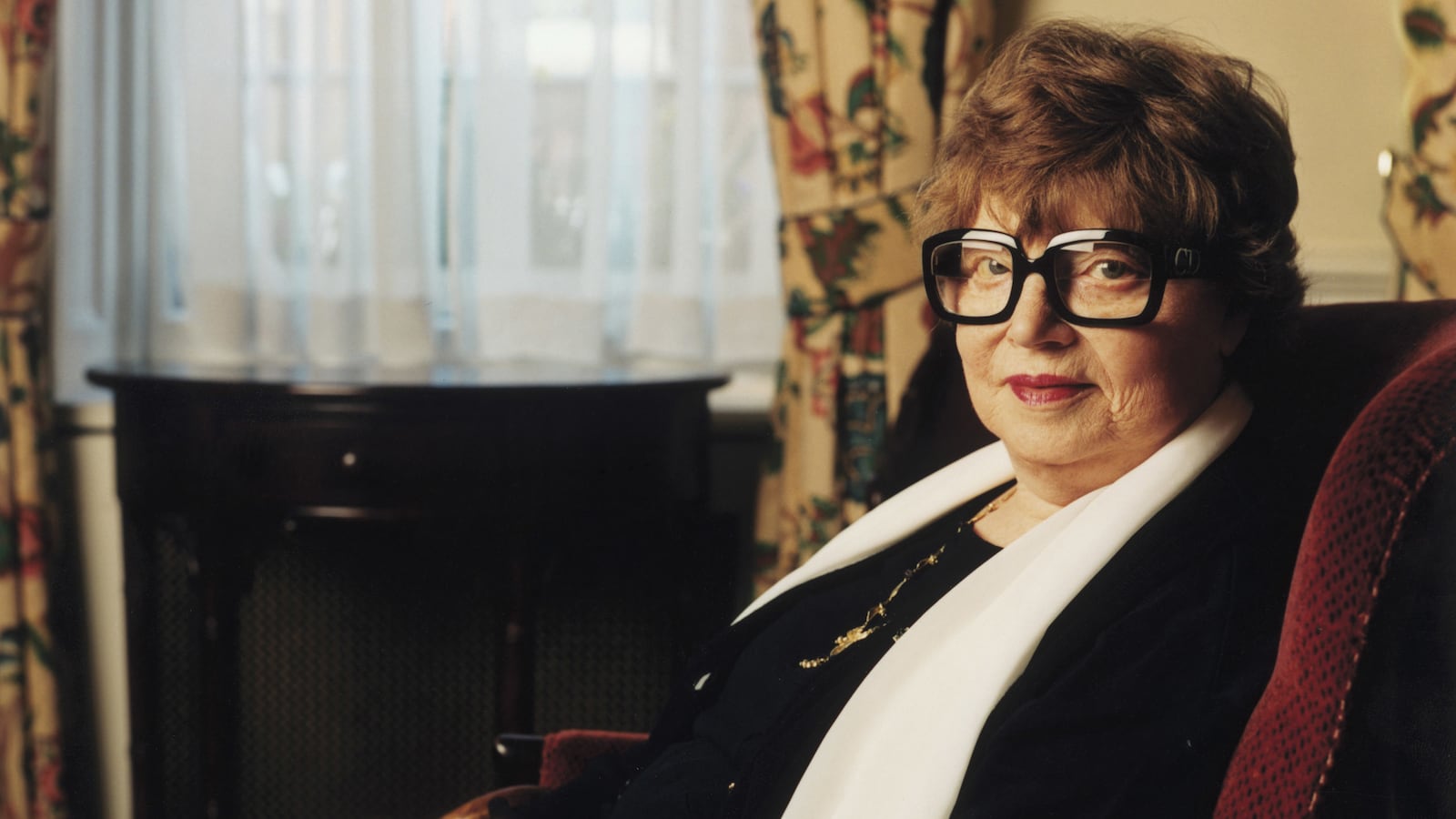Of the many and multifarious rooms involved in last year’s “A Bigger Splash: Painting After Performance” exhibition at London’s Tate Modern, I found myself continually drawn to the one that concluded the show. Lucy McKenzie’s “May of Teck” (2010), a provisional stage-set of a room with wall-sized paintings, replicated the interior architecture and décor of a once elegant, now somewhat dilapidated townhouse.
The stage-set was rendered with fake marbling, trompe l’oeil radiators, brown stains where long since removed paintings had once hung, and the scuffs and stains of years of inhabitation. The set was also furnished with the detritus of modernization (electricity sockets and wires tacked along the floor) and communal living (an old-fashioned telephone attached to the wall with penciled numbers and doodles adorning the surrounding wallpaper).
Scottish artist McKenzie’s exhibit was named after and based on her fellow countrywoman Muriel Spark’s 1963 novella The Girls of Slender Means, the action of which is set in the May of Teck Club in London’s Kensington, an establishment that “exists for the Pecuniary Convenience and Social protection of Ladies of Slender Means below the age of Thirty years, who are obliged to reside apart from their Families in order to follow an Occupation in London.”
The story is set in 1945, when “all the nice people in England were poor,” and the buildings were “in bad repair or in no repair at all, bomb-sites piled with stony rubble, houses like giant teeth in which decay had been drilled out, leaving only the cavity.”
The novel begins with this image of crumbling period detail, against the backdrop of which the young residents pursue their love lives and careers despite the limitations of the post-war utility scheme.
One of the girls owns a Schiaparelli dress, the loan of which for an evening can be traded for soap or food rations, for those who fit it, of course. When an unexploded bomb, previously buried in the garden, detonates, causing the building to teeter on the edge of collapse, the only means of escape for the girls trapped on the upper floor is through a tiny skylight in the landing’s lavatory, through which only those possessed of slender enough hips can fit.
It is well known from sunbathing efforts out on the roof that “thirty-six and a quarter was the maximum for hips that could squeeze through,” and even then, it is most easily managed naked and with a body “slippery with margarine” (or soap). Cue a most chilling scene, in which a tape measure is produced and the girls’ hips are measured, “like a scientific ritual in a hopeless case,” as the smoke creeping up through the house from the fire below billows around them.
Just as this unanticipated explosion tears through the genteel façade of the novel itself, sending the story unexpectedly spinning off into the realm of a darkly comic tragedy, Spark’s writing had the impact of a bomb-like blast, blowing apart the safe, traditional realism that had come before.
It was apt that McKenzie’s installation was part of an exhibition that explored radical new realms of artistic endeavor since 1950, the decade in which Spark published her first novel, The Comforters (1957), bursting onto the literary scene to immediate critical acclaim from novelist heavyweights such as Evelyn Waugh and Graham Greene.
The Comforters is one of eight Spark novels recently republished by New Directions (also, Loitering with Intent, Memento Mori, The Ballad of Peckham Rye, A Far Cry from Kensington, The Bachelors, Territorial Rights and The Driver’s Seat) as well as The Informed Air, a collection of essays selected and edited by Spark’s friend and long-term companion Penelope Jardine.
The essays, I’m afraid to say, are a little on the dull side, not having aged well. The novels, however, are like good vintage wines, the distinctive Spark-ian traits still warm and full-bodied and their top floral notes as potent as ever.
Her writing was profoundly postmodern from the get-go. Having previously only turned her hand to poems, biographies and (albeit prize-winning) short stories, The Comforters consciously works through Spark’s thoughts on the novel form. “I didn’t feel like a ‘novelist’ and before I could square it with my literary conscience to write a novel,” she explains later in her autobiography Curriculum Vitae (1992), “I had to work out a novel-writing process peculiar to myself, and moreover, perform this act within the very novel I proposed to write.”
Her protagonist in The Comforters, Caroline Rose, newly converted to Roman Catholicism, is writing a book on the structure of the modern novel. “I’m having difficulty with the chapter on realism,” she complains as her own fictionality is confirmed as haunted by “voices” (the sound of a typewriter accompanied by the commentary of her own thoughts narrated in the third person by a disembodied narrator only she can hear), she comes to realize she’s actually a character in a novel.
That the inspiration for this plot came from the Dexedrine-induced hallucinations Spark herself suffered from in the mid-’50s, during the period of her own spiritual conversion, adds another layer of fictional self-consciousness to an already glorious example of metafiction long before the form became fashionable.
Indeed, by the time Spark overtly returns to this mode in Loitering with Intent (1981) her fellow novelists have caught up with her. Again, a young female writer, Fleur Talbot, is caught between fiction and reality as life begins to imitate art as the members of the Autobiographical Association where she works as a secretary (fictionalizing their memoirs) begin to speak and act in the exact manner of the fictional characters in Warrender Chase, the debut novel Fleur is writing in her spare time.
What is evident in Loitering is evident elsewhere in Spark’s writing: the sharpness of her authorial voice, her distinctive pairing of tragedy and comedy so closely side by side, the near-short story-like precision upon which the action of her plots turn, and her explicit and often shocking (but never gratuitous) use of violence and cruelty. We’re told towards the beginning of The Driver’s Seat (1970) that tomorrow morning the heroine Lise will be found “dead from multiple stab-wounds,” but for now she’s boarding a plane at Gate 14 with all the other holiday-bound passengers.
The Driver’s Seat, in which the disturbed Lise seemingly orchestrates her own murder, is the first of a triumvirate of masterly but deeply unsettling works at the midpoint of Spark’s career, each of which is willowy enough for the definition of long short story, but packing a punch considerably over its weight.
Although not as explicitly “Catholic” as some of her earlier works (there’s the wonderful moment in The Comforters when young Laurence informs his grandmother that Caroline, his girlfriend, has just converted; “I thought she was looking thin,” the elderly lady replies), this trio makes for an interesting exploration of divine predestination versus personal will, played out in the puppeteer and puppet relationship between novelist and character.
In the Gothic screwball, Not to Disturb, the staff of a Swiss château spend a restless night apparently awaiting the discovery of the crime passionnel involving their married employers and their handsome young secretary playing out behind the locked doors of the château’s library.
Then, in the morbid The Hothouse by the East River, 1970s New York is haunted by ghosts of British war veterans who were employed with secret work, ostensibly unaware of their own now-distant demises.
Despite having lived in New York herself, this Manhattan setting was something of a departure for Spark. There are her Italian novels—The Public Image (1968), the story of a glamorous movie star caught up in a scandal of her own husband’s macabre making; and Territorial Rights (1979), in which the canals and winding streets of Venice play host to a series of maneuverings and machinations—but she remains most clearly associated with London.
Certain streets are unapproachable, according to the novelist and critic Philip Hensher, “without hearing Muriel Spark’s dry tones.” She spent her formative years as a writer in the city, living in dingy bedsits amid the post-war rubble, and working at various jobs “on the grubby edge of the literary world” as she describes it in Loitering with Intent, the experiences of which she later transformed into various of her novels.
Indeed, her beginnings as a writer can be traced to a singular episode in the city when, by mere happenstance during the war, she took refuge in the poet Louis MacNeice’s St John’s Wood home for a night (kindly invited by a girl she met on a crowded, delayed train who was employed by MacNeice’s wife as a mother’s help). That night, Spark, only travelling through the city, was stranded without a bed, and the poet, his wife and child were out of town; this event had “an intense imaginative effect” and filled her with the drive to become a writer.
Thank goodness she was thus snared, for even today she has no equal. Her books are as slippery and slight as her margarine-d girls who make it through the skylight, fearlessly gruesome, but all the while as elegant as a Schiaparelli dress.






